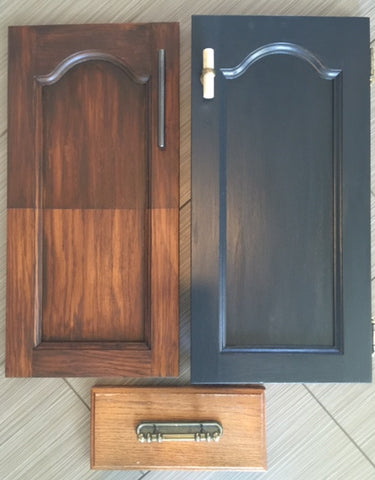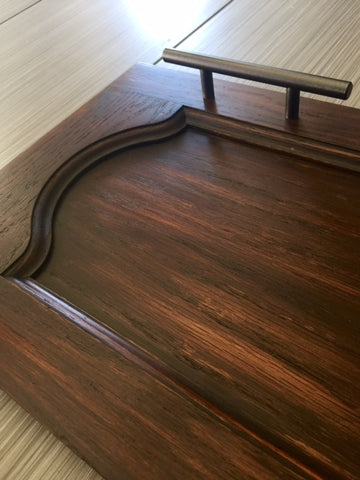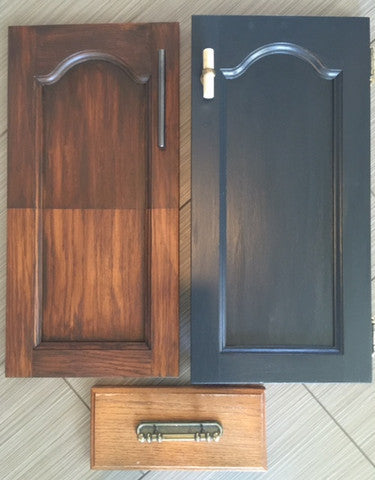If you are reasonably handy, and your cabinetry needs a pick-me-up, here are a few options to consider.

Take a look at the three cabinetry door/drawer fronts. The small drawer front is our before. It's pretty standard 80s stuff, but it can be spruced up in these two easy ways.
Some general notes:
Do a test patch on an inconspicuous spot so you can see how you will like your new finish. Also, confirm in advance if your chosen finish can be applied directly over oil or water based varnish. I don't know what you have on your doors, and since I don't know absolutely which product you will decide to go with, please check this carefully.
If you are going to fill the holes for your original hardware (mostly recommended only for chalk paint finish) do that enough in advance that it can dry before you start applying new finishes.
If you decide you want to remove your doors before refinishing them, CAREFULLY note which door goes where. Rehanging doors is not as easy as it sounds and it's really best if you can avoid it especially if you have old school hinges that are not easy to re-adjust after you are done.
This isn't terribly technically challenging, but it's labour intensive. Know you are in for some major sweat equity if you take this on, but you can really make your kitchen look dramatically different and give it a great update using these techniques at a fraction of the cost of even refacing, let alone renovating.
To use gel coat:
First, the door on the top left is treated with gel stain. It has been split down the middle so you can see the effect of using more or fewer coats of the product. The lighter part of the door has had one coat and the top has had two. The stain used is antique walnut from General Finishes from Interiors to Inspire. Keep in mind, using this technique, you can only go DARKER than your original colour and you can't really fill the holes from your original hardware. More on why that's important in a minute.
- degrease doors and cabinets with TSP or other degreaser, clean off and let dry.
- scuff surface with fine sand paper 220 grit, wipe off with tack cloth
- apply gel with foam brush and gently wipe of some of the gel with soft cloth. Let dry according to directions. If darker finish is desired, apply a second or even third coat.
This product has urethane incorporated in its formula but if you are only doing 1 to 2 coats it is not enough protection, a top coat would be needed. If you are doing less than three coats, use a top coat also sold at Interiors to Inspire.
Gel coat door hardware considerations:
If you are using the gel coat, unless you are going very dark, you probably will not be able to fill and hide the holes where your existing hardware was. For that reason, it's best if you find hardware that has the same "centre" as was originally used. Measure from one hole to the next (if you have a single pull, lucky you, you have more options that way).
I was able to find a 3" centre pull at Rona for about $5 for this door which is what I needed. If your cabinetry is european you might have a harder time finding the same size hardware as it tends to be metric.
I chose a darker brushed metal that blends into the door a little more for this one. You might also opt for something that pops against the door which will draw the eye to the hardware rather than the door.

As you can see, this really allows the wood grain to show through, but it's way less yellow/orange oak-y now and it brought the wood back to looking richer and much nicer.
How to repaint your cabinetry using chalk paint:
For the door on the top right, chalk paint was used. Chalk paint has been traditionally used for cabinetry in the UK for decades, but is only recently becoming popular here. Chalk paint is available here and here. The chalk paint door pictured has also been top coated for added durability. We happened to choose a charcoal paint for this door, but with chalk paint, you can go lighter or darker and you'll have many choices for colours.
- degrease door with TSP or other degreaser, clean off and let dry. Sanding or scuffing surface is not required.
- apply paint with brush (or roller), allow to dry
- apply second coat
- apply varnish to top coat (2 coats at least. We applied a matte varnish but you can also use the wax finish for a softer look.

As you can see in the close-up, if you have oak cabinets, you will still see the grain through the paint, but I think it's quite a nice look.
Hardware considerations for chalk painted door:
Because chalk paint is opaque, you can fill the existing holes for your hardware and start from scratch if you'd like. Just know that it's a good idea to use a jig if you decide to re-drill the holes completely. We filled one and used the top hole to put on a new pull. No need to worry about centres if this is the route you are going.
Because these doors had visible brass hinges, I chose a new pull that has an antique brass accent. Gold is coming back in a big way, so you will be right on trend. I don't recommend swapping out hinges unless you really know what you are doing. I tend not to like to mess with them at all as putting doors back on so they line up nicely again can be a nightmare.
Not sure which colour to use?
Check this link for some help in selecting a colour that won't highlight a backsplash or countertop you might not be crazy about. Still not sure and just want a little help deciding how to proceed with your DIY project? Give us a call or shoot us a message and we'd be happy to come out for a quick consultation. If you have a little more room in your budget and aren't wanting to tackle this project yourself, we can also put you in touch with professionals who would be happy to take care of it for you.

